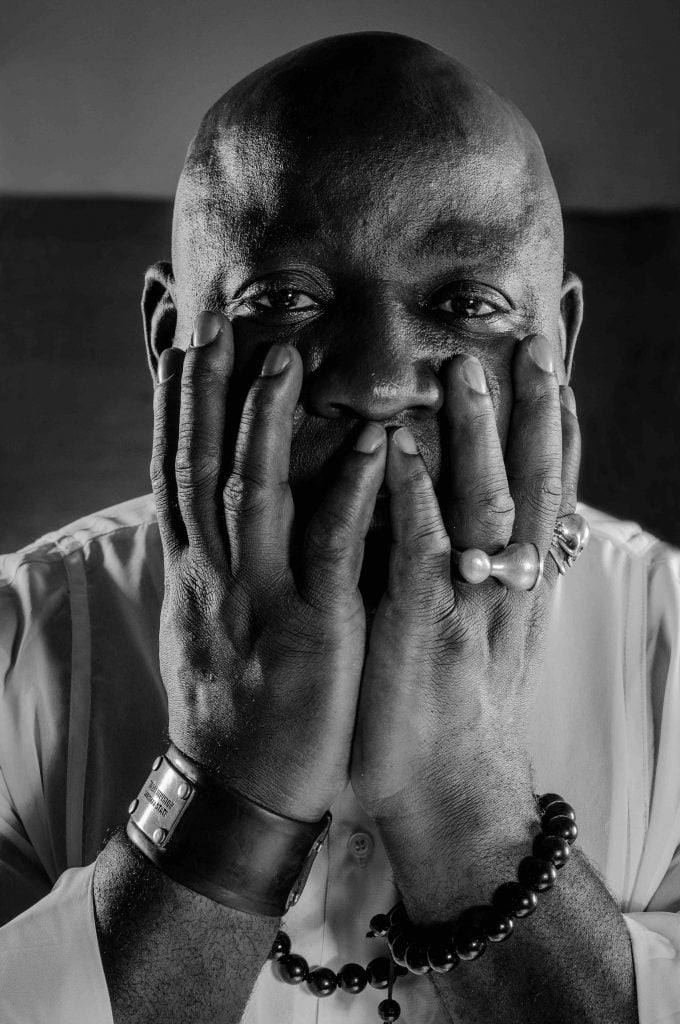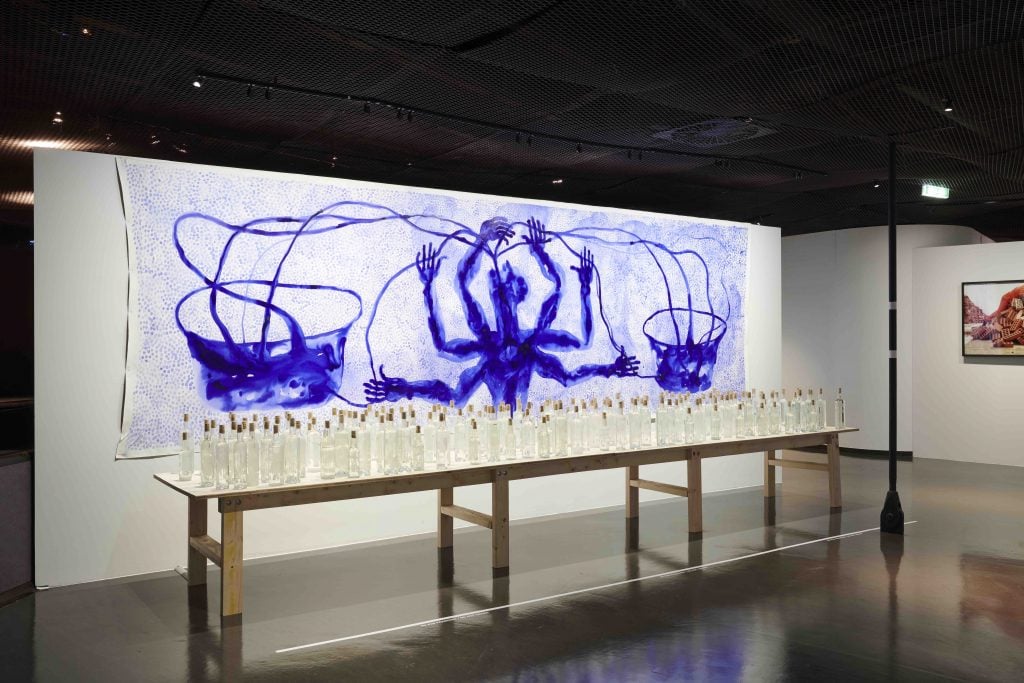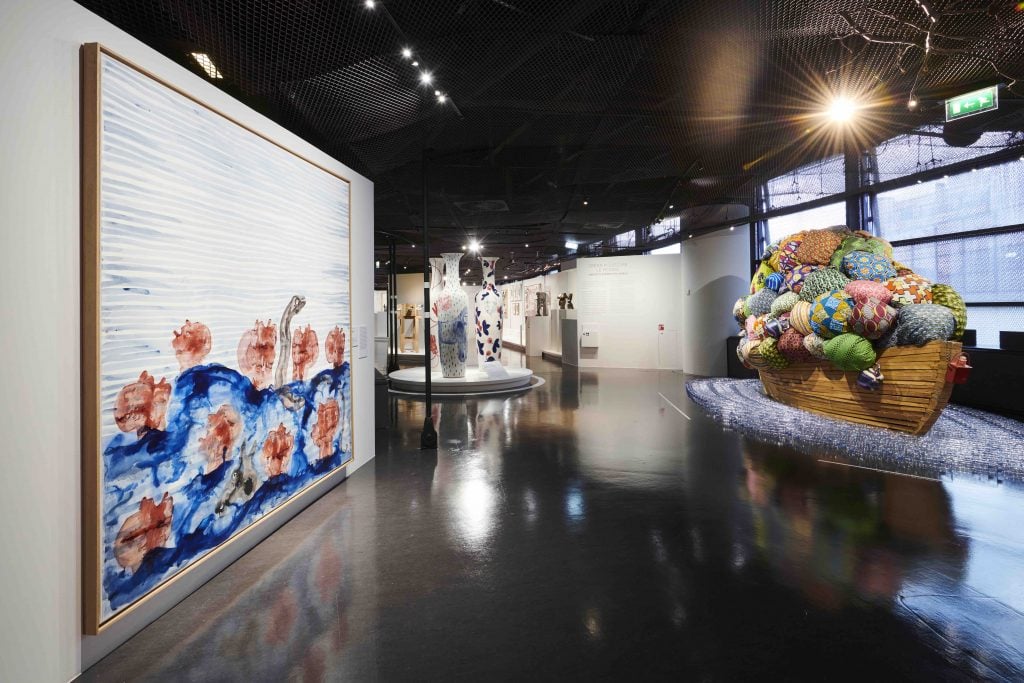Art & Exhibitions
‘An Artist Is a Visionary’: Cameroonian Artist Barthélémy Toguo on Why He Began Making Art About Viruses Well Before 2020
Toguo is the first contemporary African artist to have a solo show at Paris's Quai Branly museum.

Toguo is the first contemporary African artist to have a solo show at Paris's Quai Branly museum.

Anna Sansom

The Musée du Quai Branly-Jacques Chirac in Paris reopened last week with its first solo show dedicated to a contemporary African artist: Barthélémy Toguo. Displayed alongside historical African artworks, the Cameroonian multimedia artist’s exhibition addresses viruses, immigration, the lynching of African Americans, African dictators, and the shortage of water.
Titled “Craving for Humanity, The world of Barthélémy Toguo,” it is curated by Christiane Falgayrettes-Leveau, director of Fondation Dapper. Launched in Amsterdam in 1983 by Michel Leveau to support African and Caribbean art, the foundation was given carte blanche for the exhibition.
Particularly pertinent is Vaincre le virus! (Beat the virus) (2016). The six-and-a-half feet tall vases depicting bats, red hands, and patterns relating to the transmission of the Ebola and HIV viruses were realized five years ago when Toguo was nominated for the prestigious Prix Marcel Duchamp. After carrying out research with scientists at the Institut Pasteur in Paris to glean ideas on how to convey the viruses visually, Toguo had the vases produced in Jingdezhen, China, which is renowned for ceramics.
“In 2016, I talked about the problem of viruses and how we should encourage scientists to find the viruses that are threatening the world—it was a universal message but nobody listened to me,” Toguo told Artnet News. “Then in 2020 came the worldwide problem of Covid-19 that mobilized the world of science and medicine.”

Barthélémy Toguo, Strange Fruit. Installation view. “Craving for Humanity, The world of Barthélémy Toguo” 19 May – 5 December 2021. ©Musée du Quai Branly, photo Léo Delafontaine © ADAGP, Paris, 2021.
Nearby is the disquieting installation Strange Fruit (2017). Next to an empty noose tied to a branch are a swooping vulture, crows and aggressive dogs all in brass. Vinyl records from Billie Holiday’s 1939 record about lynchings in the American South, the sleeves painted with an open-mouthed face, are scattered among the branches. “I wanted to talk about the mistreatment of Black people and then a few years later [the murder of] George Floyd happened,” Toguo said.
Born in Cameroon in 1967, Toguo studied at the fine arts school of Abidjan, Ivory Coast, then in Grenoble and the Dusseldorf arts academy. In Dusseldorf, he was taught by the Arte Povera artist Jannis Kounellis and encountered Tony Cragg.
In 2015, his work featured in the Venice Biennale, eight years after he refused to participate in the African Pavilion organized by the Sindika Dokolo Foundation. “The proposal was reductive because Africa is not a country but a region and I maintain my position about that problematic ghettoization of African artists,” he said. “My stance upset the Italians.”
It was reading the French author Albert Camus’s 1957 Nobel Prize speech, about an artist’s obligation to move the largest number of people by offering an image of common suffering and joy, that instilled in Toguo his sense of mission.
“Camus’s thoughts on the role of an artist fascinated me,” Toguo recalled. “I told myself that I have a role in society to bring a message. For me, an artist is a visionary who has the capacity to look into the future, see societal problems and inform people through his production.”

Barthélémy Toguo, Water Matters (2020). Installation view. “Craving for Humanity, The world of Barthélémy Toguo” 19 May – 5 December 2021. ©Musée du Quai Branly, photo Léo Delafontaine © ADAGP, Paris, 2021.
Some artworks evoke ideas metaphorically. Road to Exile (2008)—a wooden boat overflowing with cushions in African fabrics and surrounded by innumerable bottles of water—expresses the precariousness of young Africans trying to reach Europe in boats that might capsize. The newest work, Water Matters (2020), made for the exhibition, comprises a painting of a figure with outstretched palms in front of a table lined with glass bottles. It pertains to Toguo’s desire to redistribute water between countries that have too little and those that have too much.
Around 50 works by Toguo are presented along with historical African artworks from Fondation Dapper, the Musée du Quai Branly, and other collections that find a resonance with his pieces. The first two parts showcase works relating to the body, such as a painting of bleeding hands wounded by nails.
“I tried to identify recurring elements in Barthélémy Toguo’s work and noticed the presence in his paintings and drawings of nails, which hark back to Christ and the crucifixion, but also to objects used by people in Congo to master negative forces,” Falgayrettes-Leveau said. “Although he didn’t consciously reflect upon this aspect of African heritage, they’re unconscious references.”

Installation view. “Craving for Humanity, The world of Barthélémy Toguo” 19 May – 5 December 2021. ©Musée du Quai Branly, photo Léo Delafontaine © ADAGP, Paris, 2021.
Toguo’s engagement as an artist extends far beyond his own practice. In 2013, he created Bandjoun Station in Cameroon, encompassing an art center, artists’ residency and coffee plantation. “There was no place to celebrate art in Cameroon and, with all my experience, I needed to give something back to Africa,” said Toguo, who divides his time between Cameroon and Paris. “All my artistic production was in western museums like Tate Modern, the Centre Pompidou and MoMA.”
Vocal about the need for the African continent to acquire artworks by its artists, Toguo added: “Whereas African masks were stolen by colonizers and remained in the west, contemporary works by Romuald Hazoumè, Chéri Samba and El Anatsui have been bought by western museums who recognize their value. But there is nothing in Africa because politicians don’t know [about contemporary art]. So I’ve created a space for artistic exchanges. Kounellis gave me three drawings and artists worldwide have given me works that I’ve installed alongside African artists like Soly Cissé and Siriki Ky.”
The Musée du Quai Branly, which is restituting 26 works to Benin, has been called upon by a group of African activists to restitute more pieces to the continent. But that is a “different issue”, pointed out Toguo, who was clearly elated about his solo show: “I’m astonished and moved because this is the first time that this curatorial eye has been applied to my work.”
“Craving for Humanity, The world of Barthélémy Toguo” is on view at Musée du Quai Branly-Jacques Chirac in Paris through December 5.